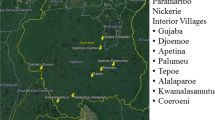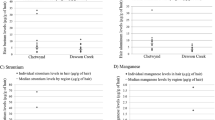Abstract
Mercury (Hg) exposure, a worldwide public health concern, predominantly takes two forms—methylmercury from fish consumption and elemental Hg from dental amalgam restorations. We recruited 630 dental professionals from an American Dental Association meeting to assess Hg body burden and primary sources of exposure in a dually exposed population. Participants described occupational practices and fish consumption patterns via questionnaire. Hg levels in biomarkers of elemental Hg (urine) and methylmercury (hair and blood) were measured with a Direct Mercury Analyzer-80 and were higher than the general US population. Geometric means (95% CI) were 1.28 (1.19–1.37) μg/l in urine, 0.60 (0.54–0.67) μg/g in hair and 3.67 (3.38–3.98) μg/l in blood. In multivariable linear regression, personal amalgams predicted urine Hg levels along with total years in dentistry, amalgams handled, working hours and sex. Fish consumption patterns predicted hair and blood Hg levels, which were higher among Asians compared with Caucasians. Five species contributed the majority of the estimated Hg intake from fish—swordfish, fresh tuna, white canned tuna, whitefish and king mackerel. When studying populations with occupational exposure to Hg, it is important to assess environmental exposures to both elemental Hg and methylmercury as these constitute a large proportion of total exposure.
This is a preview of subscription content, access via your institution
Access options
Subscribe to this journal
Receive 6 print issues and online access
$259.00 per year
only $43.17 per issue
Buy this article
- Purchase on Springer Link
- Instant access to full article PDF
Prices may be subject to local taxes which are calculated during checkout


Similar content being viewed by others
References
ATSDR. Priority List of Hazardous Substances. 2013. Available at http://www.atsdr.cdc.gov/SPL/index.html (accessed on 7 July 2014).
Clarkson TW, Magos L . The toxicology of mercury and its chemical compounds. Crit Rev Toxicol 2006; 36: 609–662.
ATSDR. Toxicological profile for mercury, 1999.
ADA Council on Scientific Affairs. Dental mercury hygiene recommendations. J Am Dent Assoc 2003; 134: 1498–1499.
Naleway C, Chou HN, Muller T, Dabney J, Roxe D, Siddiqui F . On-site screening for urinary Hg concentrations and correlation with glomerular and renal tubular function. J Public Health Dent 1991; 51: 12–17.
Franzblau A, d'Arcy H, Ishak MB, Werner RA, Gillespie BW, Albers JW et al. Low-level mercury exposure and peripheral nerve function. Neurotoxicology 2012; 33: 299–306.
Martin MD, Naleway C, Chou HN . Factors contributing to mercury exposure in dentists. J Am Dent Assoc 1995; 126: 1502–1511.
Berglund M, Lind B, Bjornberg KA, Palm B, Einarsson O, Vahter M . Inter-individual variations of human mercury exposure biomarkers: a cross-sectional assessment. Environ Health 2005; 4: 20.
Sherman LS, Blum JD, Franzblau A, Basu N . New insight into biomarkers of human mercury exposure using naturally occurring mercury stable isotopes. Environ Sci Technol 2013; 47: 3403–3409.
U.S. Food and Drug Adminstration. Appendix I: Summary of Changes to the Classification of Dental Amalgam and Mercury, 2009. Available at http://www.fda.gov/MedicalDevices/ProductsandMedicalProcedures/DentalProducts/DentalAmalgam/ucm171120.htm (accessed on 1 October 2014).
Brownawell AM, Berent S, Brent RL, Bruckner JV, Doull J, Gershwin EM et al. The potential adverse health effects of dental amalgam. Toxicol Rev 2005; 24: 1–10.
Paruchuri Y, Siuniak A, Johnson N, Levin E, Mitchell K, Goodrich JM et al. Occupational and environmental mercury exposure among small-scale gold miners in the Talensi-Nabdam District of Ghana's Upper East region. Sci Total Environ 2010; 408: 6079–6085.
Richardson GM, Brecher RW, Scobie H, Hamblen J, Samuelian J, Smith C . Mercury vapour (Hg(0)): continuing toxicological uncertainties, and establishing a Canadian reference exposure level. Regul Toxicol Pharmacol 2009; 53: 32–38.
Basu N, Goodrich JM, Head J . Ecogenetics of mercury: from genetic polymorphisms and epigenetics to risk assessment and decision-making. Environ Toxicol Chem 2014; 33: 1248–1258.
Yorita Christensen KL, Carrico CK, Sanyal AJ, Gennings C . Multiple classes of environmental chemicals are associated with liver disease: NHANES 2003-2004. Int J Hyg Environ Health 2013; 216: 703–709.
Hightower JM, Moore D . Mercury levels in high-end consumers of fish. Environ Health Perspect 2003; 111: 604–608.
Trasande L, Landrigan PJ, Schechter C . Public health and economic consequences of methyl mercury toxicity to the developing brain. Environ Health Perspect 2005; 113: 590–596.
Roman HA, Walsh TL, Coull BA, Dewailly E, Guallar E, Hattis D et al. Evaluation of the cardiovascular effects of methylmercury exposures: current evidence supports development of a dose-response function for regulatory benefits analysis. Environ Health Perspect 2011; 119: 607–614.
Salonen JT, Seppanen K, Lakka TA, Salonen R, Kaplan GA . Mercury accumulation and accelerated progression of carotid atherosclerosis: a population-based prospective 4-year follow-up study in men in eastern Finland. Atherosclerosis 2000; 148: 265–273.
He K, Xun P, Liu K, Morris S, Reis J, Guallar E . Mercury exposure in young adulthood and incidence of diabetes later in life: the CARDIA Trace Element Study. Diabetes Care 2013; 36: 1584–1589.
Cohen JT, Bellinger DC, Connor WE, Kris-Etherton PM, Lawrence RS, Savitz DA et al. A quantitative risk-benefit analysis of changes in population fish consumption. Am J Prev Med 2005; 29: 325–334.
Goodrich JM, Wang Y, Gillespie B, Werner R, Franzblau A, Basu N . Glutathione enzyme and selenoprotein polymorphisms associate with mercury biomarker levels in Michigan dental professionals. Toxicol Appl Pharmacol 2011; 257: 301–308.
U.S. Food and Drug Administration. Mercury Concentrations in Fish: FDA Monitoring Program (1990-2010). Available at http://www.fda.gov/Food/FoodborneIllnessContaminants/Metals/ucm191007.htm (accessed on 11 December 2013.
Bahnick D, Sauer C, Butterworth B, Kuehl DW . A national study of mercury contamination of fish: IV: analytical methods and results. Chemosphere 1994; 29: 537–546.
Mierzykowski SE, Carr KC, Total Mercury and Methyl Mercury in Freshwater Mussels (Elliptio complanata) from the Sudbury River Watershed, Massachusetts. USFWS 2001; Spec. Proj. Rep. FY98-MEFO-2-EC.
EPA Gulf of Mexico Program The Occurrence of Mercury in the Fishery Resources of the Gulf of Mexico. Public Health Focus Team: Stennis Space Center, MS. 2000.
Wang Y, Goodrich JM, Gillespie B, Werner R, Basu N, Franzblau A . An investigation of modifying effects of metallothionein single nucleotide polymorphisms on the association between mercury exposure and biomarker levels. Environ Health Perspect 2012; 120: 530–534.
Levine L, Fahy JP . Evaluation of urinary lead determinations I, the significance of the specific gravity. J Ind Hyg Toxicol 1945; 27: 217.
Mason HJ, Calder IM . The correction of urinary mercury concentrations in untimed, random samples. Occup Environ Med 1994; 51: 287.
McDowell MA, Dillon CF, Osterloh J, Bolger PM, Pellizzari E, Fernando R et al. Hair mercury levels in U.S. children and women of childbearing age: reference range data from NHANES 1999-2000. Environ Health Perspect 2004; 112: 1165–1171.
Centers for Disease Control and Prevention. Fourth National Report on Human Exposure to Environmental Chemicals, Updated Tables, March 2013.
Echeverria D, Woods JS, Heyer NJ, Rohlman D, Farin FM, Bittner AC et al. Chronic low-level mercury exposure, BDNF polymorphism, and associations with cognitive and motor function. Neurotoxicol Teratol 2005; 27: 781–796.
Ritchie KA, Burke FJT, Gilmour WH, Macdonald EB, Dale IM, Hamilton RM et al. Mercury vapour levels in dental practices and body mercury levels of dentists and controls. Br Dental J 2004; 197: 625–632.
Fan PL, Batchu H, Chou HN, Gasparac W, Sandrik J, Meyer DM . Laboratory evaluation of amalgam separators. J Am Dent Assoc 2002; 133: 577–584.
Ekstrand J, Nielsen JB, Havarinasab S, Zalups RK, Soderkvist P, Hultman P . Mercury toxicokinetics—dependency on strain and gender. Toxicol Appl Pharmacol 2009; 243: 283–291.
Nielsen JB . Toxicokinetics of mercuric chloride and methylmercuric chloride in mice. J Toxicol Environ Health 1992; 37: 85–122.
Pamphlett R, Ewan KB, McQuilty R, Waley P . Gender differences in the uptake of inorganic mercury by motor neurons. Neurotoxicol Teratol 1997; 19: 287–293.
Papanikolaou Y, Brooks J, Reider C, Fulgoni VL, 3rd . U.S. adults are not meeting recommended levels for fish and omega-3 fatty acid intake: results of an analysis using observational data from NHANES 2003-2008. Nutr J 2014; 13: 31.
U.S. Environmental Protection Agency Water Quality Criterion for the Protection of Human Health: Methylmercury. 2001; EPA 823-R-01-001.
Stern AH, Smith AE . An assessment of the cord blood:maternal blood methylmercury ratio: implications for risk assessment. Environ Health Perspect 2003; 111: 1465–1470.
Choi AL, Weihe P, Budtz-Jorgensen E, Jorgensen PJ, Salonen JT, Tuomainen TP et al. Methylmercury exposure and adverse cardiovascular effects in Faroese whaling men. Environ Health Perspect. 2009; 117: 367–372.
Myers GJ, Davidson PW, Shamlaye CF, Axtell CD, Cernichiari E, Choisy O et al. Effects of prenatal methylmercury exposure from a high fish diet on developmental milestones in the Seychelles Child Development Study. Neurotoxicology 1997; 18: 819–829.
Mahaffey KR, Clickner RP, Bodurow CC . Blood organic mercury and dietary mercury intake: National Health and Nutrition Examination Survey, 1999 and 2000. Environ Health Perspect 2004; 112: 562–570.
Hightower JM, O'Hare A, Hernandez GT . Blood mercury reporting in NHANES: identifying Asian, Pacific Islander, Native American, and multiracial groups. Environ Health Perspect 2006; 114: 173–175.
Park SK, Lee S, Basu N, Franzblau A . Associations of blood and urinary mercury with hypertension in U.S. Adults: the NHANES 2003-2006. Environ Res 2013; 123: 25–32.
Knobeloch L, Anderson HA, Imm P, Peters D, Smith A . Fish consumption, advisory awareness, and hair mercury levels among women of childbearing age. Environ Res 2005; 97: 220–227.
Mahaffey KR, Clickner RP, Jeffries RA . Adult women's blood mercury concentrations vary regionally in the United States: association with patterns of fish consumption (NHANES 1999-2004). Environ Health Perspect 2009; 117: 47–53.
Kim BM, Choi AL, Ha EH, Pedersen L, Nielsen F, Weihe P et al. Effect of hemoglobin adjustment on the precision of mercury concentrations in maternal and cord blood. Environ Res 2014; 132: 407–412.
Bartell SM, Ponce RA, Sanga RN, Faustman EM . Human variability in mercury toxicokinetics and steady state biomarker ratios. Environ Res 2000; 84: 127–132.
Woods JS, Martin MD, Leroux BG . Validity of spot urine samples as a surrogate measure of 24-hour porphyrin excretion rates. Evaluation of diurnal variations in porphyrin, mercury, and creatinine concentrations among subjects with very low occupational mercury exposure. J Occup Environ Med 1998; 40: 1090–1101.
Acknowledgements
We acknowledge the American Dental Association for their support. The University of Michigan (UM) field staff (Amanda Barks, Josillia Johnson and Autumn Poisson) was instrumental in subject recruitment. Lara Khadr and Autumn Poisson were instrumental for Hg analysis, and Maxwell Scher and John Francis for specific gravity analysis. This research was supported by grants from the National Center for Advancing Translational Sciences of the National Institutes of Health (award no. 2UL1TR000433), the UM Office of the Vice President for Research, the UM Environmental Health Sciences Core Center (grant no. P30 ES017885) and the UM School of Public Health. JMG is also supported by US Environmental Protection Agency (US EPA) grants RD834800 and RD83543601 and National Institute for Environmental Health Sciences (NIEHS) grants P20 ES018171, P01 ES02284401. The contents of this publication are solely the responsibility of the grantee and do not necessarily represent the official views of the US EPA or the NIH. Further, the US EPA does not endorse the purchase of any commercial products or services mentioned in the publication.
Author information
Authors and Affiliations
Corresponding author
Ethics declarations
Competing interests
The authors declare no conflict of interest.
Additional information
Supplementary Information accompanies the paper on the Journal of Exposure Science and Environmental Epidemiology website
Supplementary information
Rights and permissions
About this article
Cite this article
Goodrich, J., Chou, HN., Gruninger, S. et al. Exposures of dental professionals to elemental mercury and methylmercury. J Expo Sci Environ Epidemiol 26, 78–85 (2016). https://doi.org/10.1038/jes.2015.52
Received:
Accepted:
Published:
Issue Date:
DOI: https://doi.org/10.1038/jes.2015.52
Keywords
This article is cited by
-
Our evolved understanding of the human health risks of mercury
Ambio (2023)
-
Risk-Benefit Assessment for Total Mercury, Arsenic, Selenium, and Omega-3 Fatty Acids Exposure from Fish Consumption in Jamaica
Biological Trace Element Research (2020)
-
Mercury level in biological samples of dentists in Iran: a systematic review and meta-analysis
Journal of Environmental Health Science and Engineering (2020)
-
Oral Cavity and Allergy: Meeting the Diagnostic and Therapeutic Challenge
Current Oral Health Reports (2016)
-
An Ecological and Human Biomonitoring Investigation of Mercury Contamination at the Aamjiwnaang First Nation
EcoHealth (2016)



